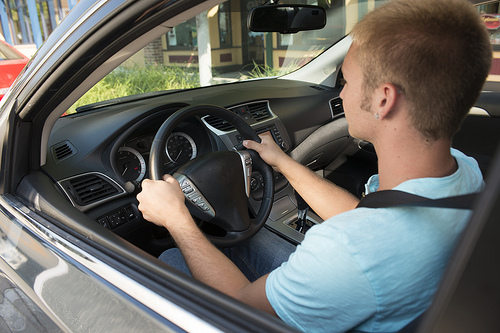How to make teenage drivers safer
Teens are disproportionately at risk just getting behind the wheel: In the U.S., teenagers age 16 to 19 have three times the rate of fatal crashes as adult drivers. But what if there was a simple way to increase teens’ safety? There is: Recent research has shown that these kids are largely driving cars without adequate crash protection. By choosing safer cars for driving teens, parents can help protect their children– as well as other drivers on the road. A recent study from Angela H. Eichelberger, Eric R. Teoh and Anne T. McCartt, “Vehicle choices for teenage drivers: A national survey of U.S. parents,” delves into the reasons behind vehicle choice, and what there is to learn about safety from their choices.

Teenage drivers aren’t driving the best cars to keep them safe, says a study. Image from State Farm.
The researchers’ goal was to update existing research on parents’ vehicle choice for their teens; to do that, they conducted a telephone survey that questioned parents and guardians about the vehicle their teenager drives, the reason they chose the vehicle for their teenager, and the cost of their cars. Via a telephone survey that targeted 12,500 parents and guardians of teens who live in the same household and have a driver’s license, the researchers were able to reach 2,783 households and 500 parents or guardians.
The results showed that teens were most frequently driving 2000-06 model year vehicles (41 percent), with 30 percent driving a more recent model and 19 percent driving an older model. In terms of car size, teens most often drove midsize or large cars (27 percent), then SUVs (22 percent), mini or small cars (20 percent), and pickups (14 percent). (Fewer were driving minivans, at 6 percent, or sports cars, at 1 percent.) And 43 percent of the cars in question were bought when the teenager started driving, or afterwards. An 83-percent majority of the kids’ cars were used vehicles, with a median cost of $5,300, and a mean cost of $9,751.
Parents were also asked about their top considerations when buying a car for their kids. The most common response was safety (23 percent), followed by a car’s low cost (16 percent). Parents were also asked what safety features they required their teenager’s vehicle have: The most frequently mentioned safety features included front airbags, seat belts, and side airbags. But few parents mentioned good crash test ratings or electronic stability control (ESC). (Features that are particularly significant for teen drivers include side airbags and ESC, which helps keep the car from rolling over in a crash.)
So, what do these findings mean for teenage drivers’ safety? As the researchers note, parents’ state that their top concern is safety, but appear to be under-informed about the most appropriate safety features for teens: namely, ESC. “Given teenagers’ elevated crash rates, it is especially important that they drive vehicles that have the most important safety features and provide adequate protection in the event of a crash,” write the study authors. “[I]t appears that parents, and their teenage drivers, may benefit from consumer information about optimal vehicle choices for teenagers.This information should include specific choices of vehicles that are both safe and economical.”
Read the study in full here, and discover the IIHS’ tips for purchasing a vehicle for a teen. Among these guidelines: avoid high horsepower; avoid mini or small cars; make sure ESC is included as a safety feature.
Related Posts
Category: Transportation

















